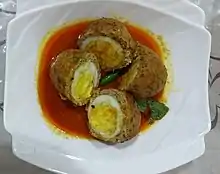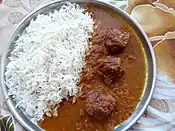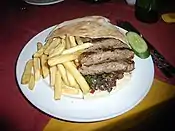Kofta
Kofta is a family of meatball or meatloaf dishes found in Balkan, Middle Eastern, South Caucasian, South Asian and Central Asian cuisines. In the simplest form, koftas consist of balls of minced meat – usually beef, chicken, pork, lamb or mutton, or a mixture – mixed with spices and sometimes other ingredients. The earliest known recipes are found in early Arab cookbooks and call for ground lamb.

There are many national and regional variations. There are also vegetable and uncooked versions. Shapes vary and include balls, patties, and cylinders. Sizes typically vary from that of a golf ball to that of an orange.
Etymology
In English, kofta is a loanword borrowed from Urdu: کوفتہ, romanized: kofta, lit. 'pounded meat' which in turn is derived from Classical Persian koftah, contemporarily kufte.[1][2][3][4] The earliest extant use of the word in the Urdu language is attested from the year 1665 in Mulla Nusrati's ʿAlī Nāma.[5][6] It was first used in English in Qanoon-e-Islam in 1832,[7] and then by James Wise in 1883.[8] The languages of the region of the kofta's origin have adopted the word with minor phonetic variations.[9] Similar foods are called in other languages croquettes, dumplings, meatballs, rissoles, and turnovers.[9][10]
History
The first appearance of recipes for kofta are in the earliest Arab cookbooks.[11][9] The earliest recipes are for large ground lamb meatballs triple-glazed in a mixture of saffron and egg yolk.[11] This glazing method spread to the West, where it is referred to as "gilding" or "endoring".[9] Koftas moved to India; according to Alan Davidson nargisi kofta were served at the Moghul court.[9]
Koftas are found from the Indian subcontinent through Central Asia, the Middle East, the Balkans, and northern Africa.[9] Koftas are found in the traditional cuisines of Iran, Afghanistan,[12] Albania, Bulgaria,[9] Georgia,[13] Armenia,[12][13] Azerbaijan,[12][13] Greece,[9] India,[9][12][14] Morocco,[9] Pakistan,[15] Romania,[16] and Turkey.[12][17] In Turkey it is "a preferred offering at communal gatherings of all kinds", according to Engin Akin.[17] In Armenia and Azerbaijan it is, along with dolma, lavash, harissa, kebabs, and pahlava, a dish of "clearly symbolic ethnic significance" often argued over by gastronationalists attempting to claim it as one of their own country's traditional dishes that has been co-opted by the other country.[13] Kofta is a popular dish among Assyrian people.[18]
Variations
Generally meat is mixed with spices and often other ingredients such as rice, bulgur, vegetables, or eggs to form a paste.[9] They can be grilled, fried, steamed, poached, baked, or marinated, and may be served with a rich spicy sauce or in a soup or stew.[9] Koftas are sometimes made from fish or vegetables rather than red meat.[19] Some versions are stuffed with nuts, cheese, or eggs.[9] Generally the size can vary from the "size of an orange to the size of a golf ball",[20] although some variants are outside that range; tabriz koftesi, which average 20 centimetres (8 in) in diameter, are the largest.[9] They can be shaped in various forms[10] including patties, balls, or cylinders.[21] Some versions are uncooked.[11]
Examples
- Chiftele, a Romanian version using ground pork mixed with mashed potatoes
- Çiğ köfte, a Turkish and Armenian version made with bulgur and sometimes raw meat
- İnegöl köfte, a Turkish style
- Islama köfte, a steamed kofta from Turkey
- Kibbeh, a category of dish in Middle Eastern cuisine which includes koftas, sometimes served raw
- Analı kızlı, a Turkish soup
- Kofta curry, having meat or vegetable balls in a curry sauce. There are many variations using different ingredients for the balls, such as kofta curries made with paneer, chicken or mutton; it derives from the Indian subcontinent.[20]
- Koofteh berenji, koofteh hamedani, koofteh nar, koofteh tabrizi and koofteh shirin-e kermanshahi, Iranian variants.[22]
- Nargisi kofta, an Indian dish in which a hard-boiled egg is wrapped in the kofta mixture[9]
- Pishtha, a meatball mentioned in the Sushrutha Samhita[23]
- Şiş köfte, a kebab-style kofta from Turkish cuisine
- Sulu köfte, a Turkish kofta soup or stew
- Tabriz köftesi, an Azerbaijani version unusual for its average diameter of 20 centimetres (8 in)[9]
- Tomatokeftedes, a Greek vegetarian version which uses tomatoes[24]
 Kotlet from Iran
Kotlet from Iran Iranian Tabrizi kofta include yellow split peas and potatoes as well as minced meat
Iranian Tabrizi kofta include yellow split peas and potatoes as well as minced meat Indian vegetable kofta curry served with rice
Indian vegetable kofta curry served with rice Egyptian cigar-shaped kofta in a pita
Egyptian cigar-shaped kofta in a pita
See also
References
- Stevenson, Angus; Waite, Maurice, eds. (18 August 2011). "kofta". Concise Oxford English Dictionary: Luxury Edition (12th ed.). Oxford University Press. p. 790. ISBN 978-0-19-960111-0.
- "kofta". Collins English Dictionary (Online). HarperCollins Publishers. n.d. Retrieved 16 March 2022.
- "Kofta". Educalingo (Online). n.d. Retrieved 16 March 2022.
- "kofta". Dictionary.com Unabridged (Online). n.d. Retrieved 16 March 2022.
- Nuṣratī, Mullā (1665). ʿAlī Nāma علی نامہ (in Urdu). p. 234.
Na tha har ġalūla nibolī te kam / Rakhe kofte [pl.] bār golīyāṅ te jam
- Fatehpuri, Farman, ed. (June 1993) [22 vols pub. 1977–2010]. "kofta" کوفتہ. Urdu Lughat (Tareekhi Usool Par) [Urdu Dictionary on Historical Principles] (in Urdu). Vol. 15. Urdu Dictionary Board.
- Shurreef, Jaffur (1832). "Appendix". Qanoon-e-Islam قانونِ اسلام [The Customs of the Moosulmans of India; Comprising a Full and Exact Account of Their Various Rites and Ceremonies, from the Moment of Birth Till the Hour of Death] (in Urdu). Translated by Herklots, Gerhard Andreas. London, England: Parbury, Allen, and Co. p. xxx. pp. xxvii, xxx:
V. Moosulman [Muslim] Cookery, (including the various Dishes alluded to in this Work). 1. Polaoos پلاؤ. ... Kofta Polaoo کوفتہ پلاؤ.
- Wise, James (1883). "Nán-baí, Roṭi-wálah". Notes on the Races, Castes and Trades of Eastern Bengal. London, England: Harrison and Sons. p. 97.
[The Nān-bāʾī's] bill of fare includes a delicious, richly-flavoured curry, Kofta, or pounded meat, roasts, and puláos. ... Koftá—hashed or pounded, and fried in Ghí.
- Davidson, Alan (2014). The Oxford Companion to Food. Tom Jaine, Soun Vannithone (3rd ed.). New York, NY. p. 448. ISBN 978-0-19-967733-7. OCLC 890807357.
- Herbst, Ron (2015). The deluxe food lover's companion. Sharon Tyler Herbst (2nd ed.). Hauppauge, New York. pp. 261–262. ISBN 978-1-4380-7621-8. OCLC 909914756.
- Brown, Ellen (2020). Meatballs : the ultimate cookbook (First ed.). Kennebunkport, Maine. p. 11. ISBN 978-1-64643-014-7. OCLC 1139766078.
- Dea, Cynthia (9 March 2015). "Where to Find the Best Meatballs in Los Angeles". KCET. Retrieved 24 August 2021.
{{cite web}}: CS1 maint: url-status (link) - Tsaturyan, Ruzanna (23 June 2017). "A culinary conflict in the South Caucasus". OpenDemocracy. Retrieved 24 August 2021.
{{cite web}}: CS1 maint: url-status (link) - Achaya, K. T. (December 1997). Indian Food Tradition A Historical Companion. Oxford University Press. p. 54. ISBN 0195644166.
- Fatima, Bushra (30 June 2015). "Pakistanis' love for the succulent kofta curry". The Express Tribune. The Express Tribune. Archived from the original on 10 July 2020. Retrieved 5 July 2020.
- "Chiftele | Traditional Meatballs From Romania". Atlas Media. Retrieved 24 August 2021.
{{cite web}}: CS1 maint: url-status (link) - Akın, Engin (2015). Essential Turkish cuisine : 200 recipes for small plates and family meals. Helen Cathcart. New York: Stewart, Tabori & Chang, an imprint of Abrams. p. 67. ISBN 978-1-61312-871-8. OCLC 921994379.
- Edelstein, Sari (2010). Food, Cuisine, and Cultural Competency for Culinary, Hospitality, and Nutrition Professionals. Jones & Bartlett Publishers. p. 594. ISBN 9781449618117.
- Abdel Fattah, Iman Adel (5 December 2013). "Bites Fil Beit: Koftet el Gambari – Shrimp kofta". Daily News Egypt. Archived from the original on 3 May 2015. Retrieved 19 April 2015.
- Fatima, Bushra (30 June 2015). "Pakistanis' love for the succulent kofta curry". The Express Tribune. The Express Tribune. Archived from the original on 10 July 2020. Retrieved 5 July 2020.
- Başan, Ghillie (2021). The Turkish cookbook : exploring the food of a timeless cuisine. [London]. ISBN 978-0-7548-3515-8. OCLC 1202053063.
- "طرز تهیه کوفته و انواع آن در شهرهای ایران". Kojaro. Kojaro.
- Achaya, K. T. (December 1997). Indian Food Tradition A Historical Companion. Oxford University Press. p. 54. ISBN 0195644166.
- Aglaia Kremezi and Anissa Hellou, 'What's in the Name of the Dish' in Richard Hosking (ed.), Food and Language: Proceedings of the Oxford Symposium on Food and Cooking 2009 (London: Prospect Books, 2010) 206




